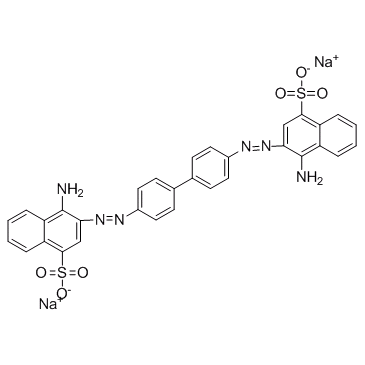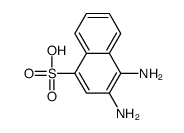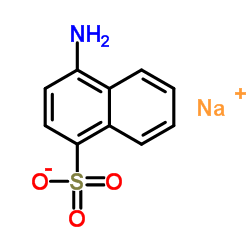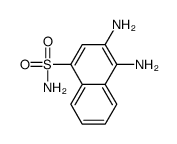Congo Red

Congo Red structure
|
Common Name | Congo Red | ||
|---|---|---|---|---|
| CAS Number | 573-58-0 | Molecular Weight | 696.663 | |
| Density | 0.995 g/mL at 25 °C | Boiling Point | N/A | |
| Molecular Formula | C32H22N6Na2O6S2 | Melting Point | >360 °C(lit.) | |
| MSDS | Chinese USA | Flash Point | N/A | |
| Symbol |

GHS08 |
Signal Word | Danger | |
Use of Congo RedCongo red is an azo dye. Congo red (CR) binding been used as a diagnostic test for the presence of amyloid in tissue sections. |
| Name | Congo Red |
|---|---|
| Synonym | More Synonyms |
| Description | Congo red is an azo dye. Congo red (CR) binding been used as a diagnostic test for the presence of amyloid in tissue sections. |
|---|---|
| Related Catalog | |
| In Vitro | Congo red histochemical stain may serve as a simple screening tool for investigating if the aggregates in mutant cells have misfolded β-pleated sheet secondary structures. Congo red histochemical dye has the ability to bind specifically to crossed β-pleated sheet structures. Wild-type HSPB1 should maintain protein homeostasis by binding proteins in non-native conformations, thereby preventing substrate aggregation. The T139M mutant, however, fails in this function and results in an accumulation of misfolded proteins, which are targeted by Congo red for intercalating between the β-pleated sheet structures. Congo red histochemical stain may serve as a simple tool to investigate if the aggregates in mutant cells have misfolded β-pleated sheet secondary structures[1]. |
| Cell Assay | HeLa cells are selected for these studies due to their large cytoplasmic volume. Cells transfected with mutant or wild-type HSPB1 constructs are grown on coverslips for 24 hr and then are stained with Congo red to determine if the aggregates display amyloidogenic properties. Briefly, cells are first fixed with 10% formalin for 10 min and stained with 1% Congo red for 5 min, followed by destaining with 0.01% potassium hydroxide in 50% ethanol. Coverslips are then passed through graded ethanol concentrations for dehydration and mounted in a mounting medium and examined by fluorescent microscopy under rhodamine filter[1]. |
| References |
| Density | 0.995 g/mL at 25 °C |
|---|---|
| Melting Point | >360 °C(lit.) |
| Molecular Formula | C32H22N6Na2O6S2 |
| Molecular Weight | 696.663 |
| Exact Mass | 696.083740 |
| PSA | 232.64000 |
| LogP | 10.78740 |
| Storage condition | Flammables area |
| Water Solubility | soluble |
CHEMICAL IDENTIFICATION
HEALTH HAZARD DATAACUTE TOXICITY DATA
MUTATION DATA
|
| Symbol |

GHS08 |
|---|---|
| Signal Word | Danger |
| Hazard Statements | H350-H361d |
| Precautionary Statements | P201-P280-P308 + P313 |
| Personal Protective Equipment | Eyeshields;full-face particle respirator type N100 (US);Gloves;respirator cartridge type N100 (US);type P1 (EN143) respirator filter;type P3 (EN 143) respirator cartridges |
| Hazard Codes | T:Toxic |
| Risk Phrases | R45;R63 |
| Safety Phrases | S53-S45-S37/39-S26 |
| RIDADR | 2811 |
| WGK Germany | 3 |
| RTECS | QK1400000 |
| Hazard Class | 6.1 |
|
SUMO1 promotes Aβ production via the modulation of autophagy.
Autophagy 11(1) , 100-12, (2015) Autophagy is one of the main mechanisms in the pathophysiology of neurodegenerative disease. The accumulation of autophagic vacuoles (AVs) in affected neurons is responsible for amyloid-β (Aβ) product... |
|
|
Swift adsorptive removal of Congo red from aqueous solution by K1.33Mn8O16 nanowires.
J. Nanosci. Nanotechnol. 13(8) , 5452-60, (2013) A swift and efficient approach to converting organic dye effluents into fresh water could be of substantial benefit. In this study, we presented facile hydrothermal synthesis of K1.33Mn8O16 nanowires ... |
|
|
Phosphorylation-independent regulation of the diguanylate cyclase WspR.
PLoS Biol. 6 , e67, (2008) Environmental signals that trigger bacterial pathogenesis and biofilm formation are mediated by changes in the level of cyclic dimeric guanosine monophosphate (c-di-GMP), a unique eubacterial second m... |
| disodium 4-amino-3-[4-[4-(1-amino-4-sulfonato-naphthalen-2-yl)diazenylphenyl]phenyl]diazenyl-naphthalene-1-sulfonate |
| DIRECT RED 28 |
| Solucongo |
| Hemorrhagyl |
| sodium salt of benzidinediazobis-1-naphthylamine-4-sulfonic acid |
| disodium,4-amino-3-[[4-[4-[(1-amino-4-sulfonatonaphthalen-2-yl)diazenyl]phenyl]phenyl]diazenyl]naphthalene-1-sulfonate |
| Congo red |
| Haemomedical |
| benzidinediazo-bis-1-naphtylamine-4 sulfonic acid disodium |
| EINECS 209-358-4 |
| Congazone sodium |
| MFCD00004028 |
| Haemonorm |
| Benzo Congo Red |
 CAS#:88246-85-9
CAS#:88246-85-9 CAS#:92-87-5
CAS#:92-87-5 CAS#:92-52-4
CAS#:92-52-4 CAS#:130-13-2
CAS#:130-13-2 CAS#:118876-83-8
CAS#:118876-83-8
